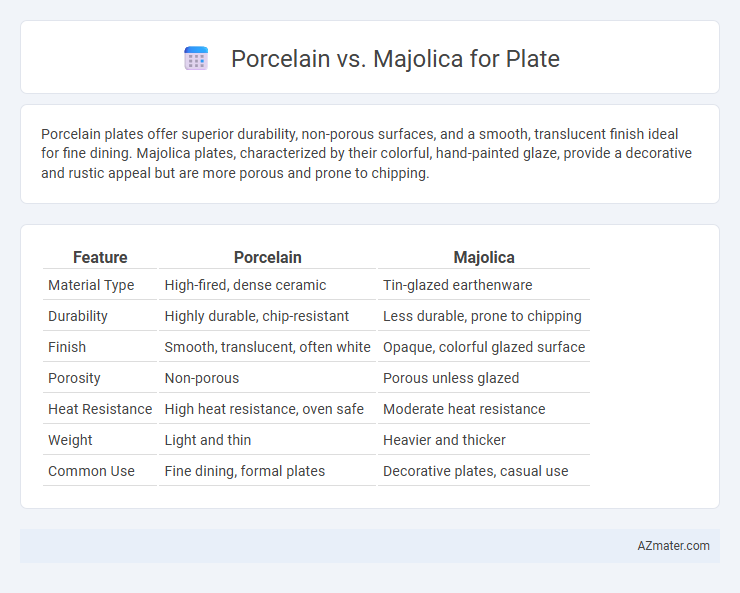Porcelain plates offer superior durability, non-porous surfaces, and a smooth, translucent finish ideal for fine dining. Majolica plates, characterized by their colorful, hand-painted glaze, provide a decorative and rustic appeal but are more porous and prone to chipping.
Table of Comparison
| Feature | Porcelain | Majolica |
|---|---|---|
| Material Type | High-fired, dense ceramic | Tin-glazed earthenware |
| Durability | Highly durable, chip-resistant | Less durable, prone to chipping |
| Finish | Smooth, translucent, often white | Opaque, colorful glazed surface |
| Porosity | Non-porous | Porous unless glazed |
| Heat Resistance | High heat resistance, oven safe | Moderate heat resistance |
| Weight | Light and thin | Heavier and thicker |
| Common Use | Fine dining, formal plates | Decorative plates, casual use |
Introduction to Porcelain and Majolica Plates
Porcelain plates are crafted from refined clay fired at high temperatures, resulting in a strong, translucent, and non-porous surface ideal for elegant dining. Majolica plates, on the other hand, feature a tin-glazed earthenware base with vibrant, hand-painted designs and a slightly porous texture, prized for its decorative appeal and rustic charm. Both materials offer unique aesthetic qualities, with porcelain emphasizing durability and refinement, while majolica highlights artistic expression and color fidelity.
Historical Background of Porcelain vs Majolica
Porcelain originated in China during the Tang Dynasty (618-907 AD) and was prized for its durability, translucency, and refined white appearance, spreading to Europe by the 16th century. Majolica, developed in the Renaissance period in Italy, features tin-glazed earthenware decorated with vibrant, opaque colors and intricate designs. While porcelain represents advancements in high-fired ceramics with a delicate finish, Majolica reflects a tradition of colorful, low-fired pottery rooted in decorative artistry.
Material Composition and Production Process
Porcelain plates are made from a refined clay mixture including kaolin, feldspar, and quartz, fired at extremely high temperatures around 1,200-1,400degC, resulting in a dense, vitrified, and translucent material renowned for its strength and durability. Majolica plates consist of earthenware clay coated with a tin or lead glaze, characterized by its porous nature and vibrant, hand-painted designs achieved through a lower firing temperature typically between 1,000-1,150degC. The production process of porcelain demands precise control over raw materials and kiln atmosphere to achieve its crystal-clear finish, whereas majolica relies on an opaque glaze that fuses pigments onto the surface, creating its signature colorful and textured appearance.
Visual Differences: Appearance and Design
Porcelain plates exhibit a smooth, glossy finish with a delicate translucency and often feature intricate, hand-painted designs that emphasize fine detail and subtle color gradients. Majolica plates are characterized by their vibrant, opaque glazes in bold, earthy hues such as cobalt blue, emerald green, and deep ochre, often showcasing raised patterns and rustic textures. The visual contrast lies in porcelain's refined elegance and lightness versus majolica's rich, tactile surfaces and vivid, folk-art-inspired motifs.
Durability and Practical Usage
Porcelain plates offer superior durability due to their high density and resistance to chipping, making them ideal for everyday use and frequent handling. Majolica plates, while vibrant and decorative, are more porous and prone to cracking or staining, which limits their practicality for heavy or long-term use. Porcelain's non-porous surface is also more hygienic and easier to clean, enhancing its functionality in both residential and commercial settings.
Cost Comparison: Porcelain vs Majolica
Porcelain plates typically cost more due to their dense, high-fired material and durability, often ranging from $20 to $100 per piece. Majolica plates, made from tin-glazed earthenware, are generally less expensive, priced between $10 and $50, but their vibrant finishes may require more careful handling. The difference in production complexity and longevity significantly influences the price gap between porcelain and majolica tableware.
Safety and Food Compatibility
Porcelain plates are highly durable, non-porous, and resistant to stains and bacteria, making them safe and ideal for food use. Majolica plates, often glazed with lead-based or tin-based finishes, may pose safety concerns if the glaze is improperly fired or chipped, potentially leaching harmful substances into food. For consistent safety and food compatibility, porcelain remains the preferred choice due to its inert surface and FDA-approved materials.
Maintenance and Care Requirements
Porcelain plates require gentle cleaning with mild detergents and soft sponges to prevent surface scratches and preserve their glossy finish, while they are dishwasher-safe but best washed by hand to maintain longevity. Majolica plates, with their vibrant, hand-painted glaze, need more delicate care, avoiding abrasive cleaners and sudden temperature changes to prevent cracking or fading of the intricate designs. Proper storage for both materials involves cushioning to avoid chipping, but Majolica demands extra caution due to its porous and less durable nature compared to the dense, non-porous porcelain.
Suitable Occasions for Each Plate Type
Porcelain plates are ideal for formal dining occasions such as weddings, upscale dinners, and fine dining restaurants due to their elegant appearance and durability. Majolica plates, characterized by their vibrant colors and artistic designs, are perfect for casual gatherings, garden parties, and rustic-themed events where a decorative and lively table setting is desired. Choosing between the two depends on the event's formality and aesthetic preference, with porcelain offering a classic sophistication and majolica providing a charming, handcrafted appeal.
Which to Choose: Porcelain or Majolica?
Porcelain plates offer superior durability, a smooth non-porous surface, and a classic, elegant appearance ideal for everyday use and formal dining. Majolica plates feature vibrant, hand-painted glazes and a rustic aesthetic, perfect for decorative table settings or casual, artistic presentations. Choose porcelain for longevity and versatility, or majolica for unique, colorful artistry that enhances casual dining experiences.

Infographic: Porcelain vs Majolica for Plate
 azmater.com
azmater.com